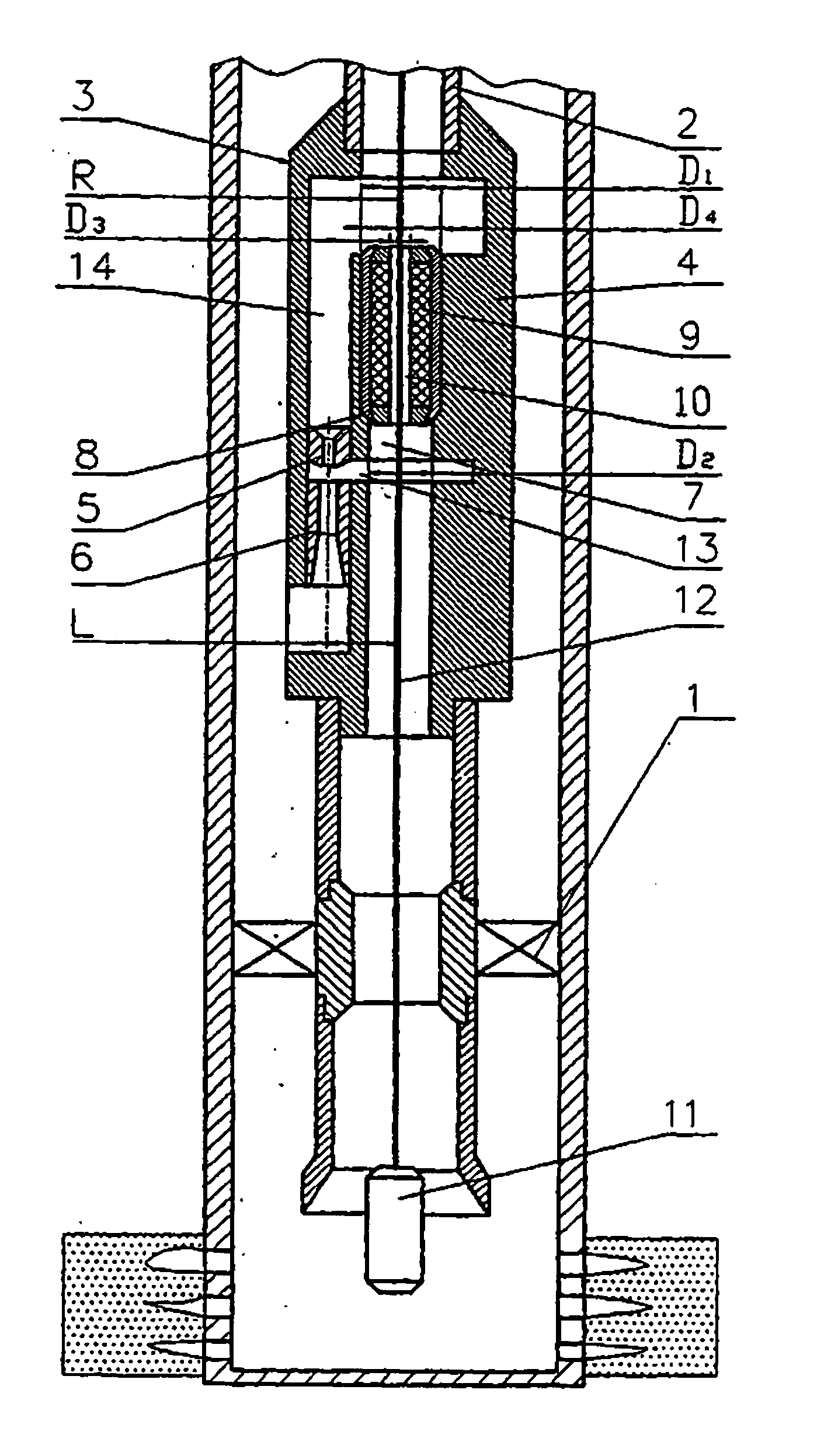[0010] The objective of this invention is to optimize the dimensions of various components of the construction of the well jet device and the sequence of operations when carrying out works on intensifying the well exploitation and, owing to it, to raise the efficiency of well jet device operation in developing and testing wells.
[0013] The analysis of the well jet device has shown that the reliability and efficiency of its operation may be improved both by making various components of the device under strictly defined dimensions and by carrying out works in the well in a strictly defined succession. During the operation of the device different well
modes are studied. It is required to install and remove the sealing
assembly, to move the transmitter and receiver-
transducer of physical fields along the well. It has been found that it is advisable to make the diameter of the bigger step in the through passage, which is located above the mounting seat for the sealing
assembly, at least 0.5 mm greater than the diameter of the step in the through passage, which is located below the mounting seat, and the diameter of the axial passage in the sealing
assembly should not exceed 0.6 outer diameter of the sealing assembly. In the result, the sealing assembly is securely installed on the mounting seat and possible overflows through the sealing assembly are minimized. The arrangement of the active
nozzle axis at a distance equal at least 1.1 radii of the bigger step in the through passage, when making the nozzle axis parallel to the axis of the through passage, enables to determine the least possible distance between the axis of the nozzle and that of the through passage of the jet pump and, consequently, enables to determine the maximum permissible dimensions of the jet pump body that is of much importance, since the diameter of the well is the main
limiting factor when arranging equipment in the well. The possibility of replacing the sealing assembly with other functional inserts and the possibility of placing, instead of the transmitter and receiver-transducer of physical fields, other well instruments, in particular a perforator, an ultrasonic transmitter, a sampling device, a
thermometer, a pressure gauge, etc., enables to conduct various works, e.g., to pressure-test the packer, transfer the well in the flow mode, conduct works on perforating the productive stratum and perform other operations without lifting the jet pump and the
piping string from the well. In the result, the possibilities of the well jet device in conducting studies and repair and restoration works in the well are expanded and the time necessary for such works is shortened. Making of inserts with the axis aligned with the axis of the through passage enables to reduce the possibility of inserts being stuck in the process of their installation or removal, which increases the reliability of operation of the well jet device.
[0014] Of no lesser importance is the rational organization of works aimed at exploring the well, which enable to obtain more adequate information on the condition of the well and the productive stratum, and, due to it, accelerate the process of restoring the well output. In particular, background measurements of temperature and other physical fields in the operation of lowering the transmitter and receiver-transducer of physical fields enable to get, prior to initiating inflow from the stratum, preliminary data on the present condition of the well, which makes it possible to elaborate practical measures for exploring the well and more adequately interpret the well exploration results in the mode of inflow from the stratum. Moving the transmitter and receiver-transducer of physical fields along the well, especially in the area of the productive stratum, both when the jet pump is operated or when it is
shut down, enables to take dynamic and static characteristics of the well. In the course of exploration it has been found that adequate accuracy of obtained data may be obtained when moving the transmitter and receiver-transducer of physical fields with the speed from 0.1 to 100 meters per minute and at changing bottom-hole pressure stepwise in the range from the normal stratum pressure to 0.01 stratum pressure. The installation of the functional inserts enables, apart from the above-stated possibilities, to organize different
modes of well operation, in particular, it becomes possible not only to get data on the composition of the fluid coming from the productive stratum, but also take important characteristics of the well, such as
record a stratum pressure restoration curve in the area below the packer, this possibility being achieved due to reduction in the bottom-hole pressure up to a value being 0.01 of nominal and subsequent sharp stopping of supply of the liquid working medium to the nozzle of the jet pump, and, what is most important, the well jet device enables to make recordings repeatedly at various
modes in the above-stated range. As the result, the reliability of the obtained data is significantly improved. All the above-indicated works may be conducted without numerous re-installations of the equipment in the well, which improves the efficiency of the well jet device greatly. After the completion of a cycle of the works on exploring and restoring the well workability, the whole cycle may be repeated, also without the necessity to re-install the equipment in the well. Thus, the scope of investigations carried out in the well has been expanded, which is of importance when carrying out restoration works.
[0015] In the result, the objective of the invention--to optimize-the succession of operations and the dimensions of various components of the well jet device--has been achieved, and, owing to that, the efficiency of operation of the well jet device has been improved.
 Login to View More
Login to View More  Login to View More
Login to View More 


